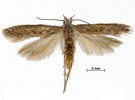Two Pukekawa  trials are showing some early promise for potato growers when it comes to greater control of the potato tuber moth, Phthorimaea operculella (PTM).
trials are showing some early promise for potato growers when it comes to greater control of the potato tuber moth, Phthorimaea operculella (PTM).
The pest, which comes from South America and has now been found in over 90 countries, particularly presents a problem around Pukekohe. This is due to the area’s dry, hot summers and mild winters which allow potato growers to leave their crops in the ground from mid-January through to April. But cracks in the volcanic clay soils provide plenty of opportunity for tuber infection by PTM larvae.
Organophosphate pesticides have been relied on at the later stages of potato growth for PTM control but due to overuse, environmental impact and resistance developing many are now being phased out, said Pukekohe company, Inta-Ag’s chief executive officer, Shane Smith.
Integrated pest management (IPM) strategies have been looked to for the future, but biological controls can be affected by ultraviolet light or rain. While irrigation is one of a number of cultural methods used, growers face a trade off with late crop potatoes left in the ground, as they would prefer to use this water on their still growing crops to increase yields, he said.
IPM programmes are being focused on but being slower to work and often working at very specific growth stages of the pest, growers and agronomists will need to build up an understanding of how this can be integrated into a future programme, he believes. So Inta-Ag has been running a trial on a potato grower’s land at Pukekawa using straw mulch to see what effect it can have on PTM. The one hectare trial site had 10 tonne of straw mulch applied in October last year with several traps set up to catch PTM as well as TPP.
Straw mulching inspired by organic methods to manage PTM
Shane said he was aware of the mulching technique being used by organic potato growers in the United Kingdom which kept the soil moisture levels higher as well as preventing the PTM larva getting to potato tubers so easily. Mulching also brought about several other benefits which weren’t foreseen, with growers there noticing fewer weeds in their crops and better disease control, particularly when it came to sclerotinia.
It was too early to yet tell how effective mulching was with full results from the Pukekawa trial expected in April or May when PTM damage can be fully assessed after the potato crop has been in the ground for some time. But he said from his weekly visits to the trial site it already appeared that nightshade, potato growers’ worst weed threat, was being kept at bay.
For more information: potatoesnz.co.nz
Tel.: +64 0800-399-674
Photo source: Nl.m.wikipedia.org
